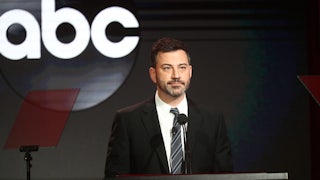The same week ABC temporarily shut down Jimmy Kimmel Live!, JD Vance stepped in to host The Charlie Kirk Show, livestreamed from the White House. And with that, the ongoing crisis of American democracy had finally, inevitably, definitively stumbled its way onto the TV beat. It hasn’t been much framed this way, but, like Jimmy Kimmel, Charlie Kirk was a talk-show host. His eulogists preferred to romanticize his campus debates, his public outreach, his ministry, but for many people who knew of him, including some of his most ardent fans, he was famous for hosting a show they watched. While he modeled himself more on Rush Limbaugh than on David Letterman, and while his program aired online rather than through a broadcast or cable network, Kirk’s most public vocation was being the star of The Charlie Kirk Show, a podcast that was also streamed as online video.
When Vance took over hosting duties for the first scheduled episode after Kirk’s assassination, he wasn’t just paying tribute; he was taking the helm of a major media institution. Even in the moment, this struck me as both a potent form of mourning—I’m sure Kirk’s legions of followers were moved by the idea of someone like Vance so directly taking up Kirk’s cause—and a statement of sorts. Vance’s team could have released his own edited video; instead, he did a guest-hosting gig that turned the White House into a soundstage and lent the stature of his office to a political podcast video. It was a gesture of deference to Kirk, and to his teeming audience, as well.
Later that night, Jimmy Kimmel hosted a humdrum episode of his long-running late-night show. In his monologue, he made a few conventional, gimlet-eyed jokes about the administration’s scramble to make sure no one would think the killer was right-wing, and its eagerness to “score political points” once his identity was made public. On Wednesday, however, FCC chief Brendan Carr appeared on a podcast and called for ABC to “take action on Kimmel,” saying, in a veiled threat, “We can do this the easy way or the hard way.” Later that day, Nexstar and Sinclair—two media conglomerates that own a large number of ABC regional affiliate stations—announced they’d be preempting Kimmel’s show. And finally, that afternoon, ABC—which is owned by Disney—announced it had suspended Kimmel’s show indefinitely. In a scrum on Air Force One, Trump applauded the move. “All they do is hit Trump. They’re licensed,” he said. “They’re not allowed to do that.” If this summer’s cancellation of Stephen Colbert’s Late Show felt like an instance of a major network “obeying in advance” by shuttering a liberal institution to please the president, the temporary shutdown of Jimmy Kimmel Live! was just an instance of regular old obedience.
So, for the past couple of weeks, the Trump administration’s attack on free speech has most prominently played out on-screen, within the constraints of the talk-show genre, old and new. It’s a familiar place for Trump and Vance, both of whom ascended in part by making memorable guest appearances on exactly the same kinds of talk shows they commandeered last week. But the landscape of TV, streaming, and online video today is an unstable one. Linear TV—the battleground of this recent fight over late-night—is no longer the powerhouse it once was. Beset by private equity investors who defiantly don’t care about on-screen product, by politically motivated lawsuits and acquisitions, and by a fractured, atomized audience, the major networks are American icons in decline and under duress. All this makes TV unusually vulnerable: Steeped in its former glory, it appears a substantial and worthwhile target, and in its current, ailing state, it’s also an easy one.
Donald Trump has always been a creature of the screen. James Poniewozik, in his regrettably still-relevant 2019 book, Audience of One: Trump, Television, and the Fracturing of America, argues that television was not just the medium for Trump’s rise, but a kind of partner in it. In Poniewozik’s account, the Trump we know is not someone whose spectacular acumen as a wheeler and dealer brought him national fame, but rather a television character Trump himself worked quite hard to create over a period of years. From his spectacular interviews in the early 1980s, through to his starring role on the hit reality TV series The Apprentice in the aughts, to his regular “Mondays with Trump” call-in feature on the Fox and Friends morning show in the 2010s—where he would try out the political positions that eventually coalesced into the MAGA movement—Trump made himself on TV. “[Trump] watched TV, and then he courted TV, and then he starred on TV, and then he became TV,” Poniewozik writes, “He achieved a psychic bond with the creature, it lowered its head, let him climb on its back, and carried him to the White House.” But this devotion had a cost.
Like that of any screen addict, Trump’s universe became limned by television. And while he was able to use the medium as a tool in his rise, he became subject to its fractures and fantasies once in power. Seemingly every tell-all memoir published by every former employee of the first Trump White House describes a man whose appetite for watching TV was essentially endless. In 2018, the journalist Michael Wolff made the then-scandalous revelation that, every morning, Trump would start the day with three hours of dedicated TV time in his residence, but, by 2020, The New York Times was reporting that the president routinely spent as many as seven hours watching TV every morning, before heading to work around noon. Just this summer, NBC News reported that Tulsi Gabbard, frustrated at Trump’s unwillingness to read briefing materials, was considering the possibility of, “creating a video version of the [president’s daily intelligence briefing] that’s made to look and feel like a Fox News broadcast.” Gabbard’s not the only one who has felt that the best way to reach to her boss is through the tube. “As a candidate, Trump controlled TV,” Poniewozik writes. “As a president Trump would be controlled by TV.”
There’s been lots of talk, intensifying over the past few weeks, of the way that Trump is adapting Hungarian strongman Viktor Orbán’s playbook in the U.S. In particular, scholars and commentators have pointed to Orbán’s aggressive consolidation of power over independent media as a pattern Trump may replicate. The difference is that Trump just absolutely loves TV. Yes he wants to control it, and yes he wants to use it to crush dissent. But there’s also something seemingly earnest about the president’s desire to do well on TV, to break down ratings, to call hits and flops. We’re all imagining that Trump wants to control television the way an autocrat would, but what if what he really wants is to control television the way an executive would? As the late-night comedy writer Greg Iwinski recently told journalist Laura Bradley, “A man who has been obsessed with television his entire life finally has brow beat all three branches of government into a place where he can pick what’s on TV.”
JD Vance has always been a skilled reader of the room. A dull speaker and uninspiring—if well-funded—retail politician, Vance owes a great deal of his success to a series of impassioned appearances on right-wing video podcasts much like Charlie Kirk’s. In a recent essay in The New Yorker, Andrew Marantz described Vance’s takeover of Kirk’s show as the completion of the “politics-as-talk-show singularity.” Vance has spent years submitting himself to the full spectrum of conservative online video creators, from Jack Murphy to Tucker Carlson, and bringing The Charlie Kirk Show to the White House was a huge move to collect this massive, floating, amorphous audience under the institutional umbrella of the executive branch. As Laura Bradley wrote recently, “Audiences are more fragmented than ever, particularly following the rise of video podcasts and YouTube interview shows like Hot Ones and Chicken Shop Date, which command huge audiences and compete with late night for A-list guests. Next to them, broadcast series look like creaky institutions with aging audiences and diminished cachet—even if most of these buzzy new shows could easily live on linear late night.” Vance gets this.
Donald Trump, on the other hand, is a linear TV president. He may be an exile, but these are his people, and this is his form. So while Trump’s chief lieutenant works hard to build the kind of young, online following that might serve to ensure the long reign of Trumpist leaders in this country, his boss is shouting at the TV set again.
In a recent polemical newsletter post, the former ABC News data analyst G. Elliot Morris made the relatively simple point that the Trump administration, despite appearances, is historically unpopular across most metrics. And yet otherwise august institutions like universities and law firms, for instance, continue to behave as if it isn’t. They fold against Trump as if he wields the unquestioned mandate of the people, rather than approval ratings that are deep underwater. In light of this, Morris is most puzzled by the capitulation of broadcast networks like ABC. “The failure of ‘old media’ in Trump’s second term is endemic to both the business models of mainstream broadcast TV corporations and the philosophies of the executives steering the ship, especially on the news side,” he writes. While late-night shows might once have been archetypal broadcast programs, populist entertainments with wide reach, Morris suggests they have long since become niche, politicized forms like everything else. But network executives have not caught up to this reality. So the cancellation of Colbert and the attempted cancellation of Kimmel are little more than pathetic pleas from networks who’ve lost their juice, to a president who is, at the moment, not quite as juicy as he seems.
Trump, of course, was a key architect of that polarization of the television landscape, but his obsession with late-night makes me wonder if even he still holds onto a romantic attachment to the broadcast era from whence he came. Vance’s inroads with the podcast set have clear value; of what political value is Trump’s war against a form whose influence, popularity, and even financial viability have been waning for years?
The generous read is that Trump sees an easy target. As Laura Bradley’s reporting shows, late-night has been dying of self-inflicted wounds for far longer than Donald Trump has been waging war against it. Network executives are scared of political retribution, and Trump gets to put Stephen Colbert’s head on a pike next to the paved-over Rose Garden. It doesn’t take much to topple that Jenga tower, but as its pieces crash to the ground, they provide precisely the kind of—televised—spectacle of power and mastery that’s always been Trump’s signature. “They wanted Trump and Carr to wield authoritarian pressure to bully networks into silencing someone whose speech about Kirk—but also about Trump—they hate,” Greg Sargent has written. “And when that actually worked, they tried to recast it as a sign of the cultural times, as an indication that the culture is moving inexorably in Trump’s direction.” If Trump can’t move the voters, at least he can move the TV executives.
But if attacking big, legacy, populist institutions like the late-night talk shows is a gambit for Trump to appear more popular, that gambit might backfire by inadvertently breathing life back into that dying form. Last quarter, Kimmel ran a pretty distant second to Colbert in the ratings, and all three major network late-night fellows were dwarfed by Fox News’s Greg Gutfeld, whose own late-night show starts a bit earlier than theirs. But not this week. In his return broadcast, with nearly a quarter of ABC affiliates preempting his show, Kimmel pulled 6.26 million viewers. His average before getting temporarily shelved was 1.42. But what’s remarkable is less that Kimmel’s return did big numbers—we’ll see if viewers stick around—than that his return came on the heels of a tremendous popular outcry. People canceled their Disney+ subscriptions and organized boycotts of affiliate advertisers, and celebrities spoke out at every opportunity. As Kimmel himself pointed out in his monologue, he even received impassioned support from right-wing figures such as Ted Cruz and Ben Shapiro. For at least this week, late-night was popular, and bipartisan, again. And Donald Trump is the reason why.
All the same, television is in the process of being captured by this regime, no matter who’s hosting the late shows. Larry Ellison, the conservative billionaire, is currently trying to buy up a slate of media outlets, including CBS, CNN, and even part of TikTok. And once Bari Weiss is editorial director of CBS News, it might feel silly in retrospect to have been so cheered about Ted Cruz and Pedro Pascal joining forces to get the former host of The Man Show back on the air. If Trump himself is weaker than he appears, so too is his beloved television. Private equity investment in companies like Warner Bros. Discovery has long since transformed these grand old institutions into fungible assets to be built up, bundled, and occasionally thrown overboard.
Broadcast TV’s symbolic value as a pillar of American culture and late-night’s specific symbolic value as a bastion of free speech remain strong—regardless of ratings, people clearly understand what an attack on Colbert or Kimmel means. While the public outcry about Kimmel was invigorating and even inspiring, it’s a story about the success of collective action, not the resilience of TV. If Disney’s Bob Iger felt Kimmel was essential to the value of his media conglomerate, he could have taken a bold, historic stand in the first place. That symbolism, though, didn’t mean much to Iger, and, moving forward, it’s not going to protect the medium of which he is a steward. The president knows this. And he knows it because, even if Kimmel and Colbert are hemorrhaging viewers, and even if linear TV no longer draws the numbers it used to, Donald Trump is still watching.






